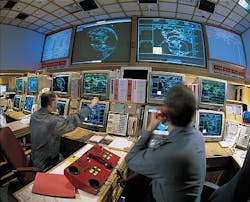ISR, command and control, unmanned vehicles, and EW could be winners in DOD budget
SAN DIEGO, 27 Jan. 2012. Military electronics industry experts are optimistic for the continued health in military electronics spending for intelligence, surveillance and reconnaissance (ISR); command, control, computers, and intelligence (C4I), unmanned vehicles, and electronic warfare (EW) in the upcoming fiscal year 2013 DOD budget request for the U.S. Department of Defense (DOD), which is scheduled for public release and submission to Congress on 13 Feb.
"We're focusing on the ISR and EW markets; that's where we see the defense budget as the strongest," explained Bud Jewett, director of business development at Crane Aerospace and Electronics in Lynnwood, Wash. Jewett made his comments in an interview with Military & Aerospace Electronics this week at the AFCEA West 2012 conference and trade show in San Diego. "We see growth in UAVs [unmanned aerial vehicles], and a merging of manned and unmanned platforms for ISR."
UAVs should be a major emphasis in the DOD budget for years go come, agrees Bill Ripley, director of business development for mission and payload systems at Themis Computer in Fremont, Calif., a specialist in embedded computing. "We see an upswing in UAV payloads and ground stations," Ripley says.
With a tight budget anticipated -- and perhaps a shrinking of the DOD budget for the first time since 1998 -- military leaders will be looking to keep existing systems and platforms in the field for as long as possible, while still enhancing capability. That will be mean a big emphasis on technology upgrades and technology insertion.
"Upgrades and technology insertion will be some of the only ways the military will be able to get the capabilities they need," Ripley says. As far as Themis is concerned, "a lot of the hardware we offer is applicable to vetronics, avionics, and maritime applications," Ripley says. As such, Themis should be well positioned to capitalize on DOD efforts in system upgrades and technology insertion.
Few new architectures
"The military is trying to extend the life of existing systems, and are not moving to new architectures," points out Amos Deacon III, president of rugged data storage specialist Phoenix International Systems in Orange, Calif. "It's not devastating because we support our legacy products, but I would much rather direct our customers to new technology."
A reluctance for defense systems integrators to move quickly to new electronic architectures and technologies in efforts to save money most likely will bode well for military electronics suppliers financially, but may be challenging technologically, Deacon explains.
"People don't want to change their technologies, so it's hard for us to maintain our capability," Deacon says. "Our go-forward programs may disappear, and that will hurt us, as we and other companies will have less incentive for technology development."
U.S. Defense Secretary Leon Panetta, in a preview of the 2013 DOD budget request, says DOD is looking at a $525 billion request that would bolster special operations forces, expand the U.S. inventory of UAVs, and enhance naval technology. President Obama has said the 2013 DOD request will emphasize a gradual reduction in the number of solders and Marines in the U.S. defense force. The Army today has about 570,000 troops, which is up from about 482,000 before the wars in Iraq and Afghanistan. Pentagon leaders now would like to shrink the Army to about 520,000 troops, perhaps even more.
The 2013 budget overall would seek to maintain the U.S. military's ability to fight a land war with North Korea simultaneously with military efforts to prevent Iran from closing the Strait of Hormuz, despite the anticipated deep cuts in conventional forces.
Reduced number of platforms
"We will see reduced numbers of new platforms, such as the Joint Strike Fighter, and delays in the Air Force Long-Range Strike Bomber," says Crane's Jewett. "We see major airborne platforms and upgrades being pushed out," agrees Themis's Ripley. "The JLTV [Joint Light Tactical Vehicle] program is being pushed out, but it's a good thing that program even still exists. The mission is still there."
JLTV would be somewhat of a replacement to the U.S. High Mobility Multi-Wheeled Vehicle, otherwise known as the Humvee. It would be a major battlefield system for surveillance, command and control, and reconnaissance, and would have sensors and electronics to make the most of that mission, Ripley says.
As far as embedded computing suppliers are concerned, Ripley predicts the 2013 DOD budget request will provide plenty of opportunities, but not at the level the defense industry saw as recently as three years ago.
"Embedded computing will be hurt if we look at what we saw three years ago," Ripley says. "The opportunities are still there, but some of will have to go outside of our comfort zones to find them."
ISR, command and control, unmanned vehicles, and EW could be winners in DOD budget. http://bit.ly/wjM06z #in #milaero
